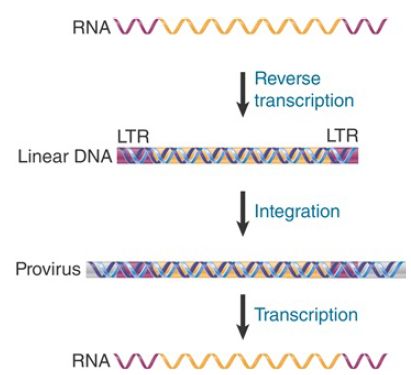
The Retrovirus Life Cycle Involves Transposition-Like Events
 المؤلف:
JOCELYN E. KREBS, ELLIOTT S. GOLDSTEIN and STEPHEN T. KILPATRICK
المؤلف:
JOCELYN E. KREBS, ELLIOTT S. GOLDSTEIN and STEPHEN T. KILPATRICK
 المصدر:
LEWIN’S GENES XII
المصدر:
LEWIN’S GENES XII
 الجزء والصفحة:
الجزء والصفحة:
 23-4-2021
23-4-2021
 2453
2453
The Retrovirus Life Cycle Involves Transposition-Like Events
KEY CONCEPTS
- A retrovirus has two copies of its genome of singlestranded RNA.
- An integrated provirus is a double-stranded DNA sequence.
- A retrovirus generates a provirus by reverse transcription of the retroviral genome.
Retroviruses have genomes of single-stranded RNA that are replicated through a double-stranded DNA intermediate. The life cycle of the virus involves an obligatory stage in which the doublestranded DNA is inserted into the host genome by a transpositionlike event that generates short direct repeats of target DNA. This similarity is not surprising, given evidence that new retroviruses have arisen repeatedly over evolutionary time as a consequence of the capture by retrotransposons of genes encoding envelope proteins, which makes infection possible.
The significance of this integration reaction extends beyond the perpetuation of the virus. Some of the consequences are as follows:
- A retroviral sequence that is integrated into the germline remains in the cellular genome as an endogenous provirus. Like a lysogenic bacteriophage, a provirus behaves as part of the genetic material of the organism.
- Cellular sequences occasionally recombine with the retroviral sequence and then are transposed with it; these sequences may be inserted into the genome as duplex sequences in new locations.
- Cellular sequences that are transposed by a retrovirus may change the properties of a cell that becomes infected with the virus.
The particulars of the retroviral life cycle are expanded in FIGURE 1. The crucial steps are that the viral RNA is converted into DNA, the DNA becomes integrated into the host genome, and then the DNA provirus is transcribed into RNA. The enzyme responsible for generating the initial DNA copy of the RNA is reverse transcriptase. The enzyme converts the RNA into a linear duplex of DNA in the cytoplasm of the infected cell. The DNA also is converted into circular forms, but these do not appear to be involved in reproduction.

FIGURE 1. The retroviral life cycle proceeds by reverse transcribing the RNA genome into duplex DNA, which is inserted into the host genome, in order to be transcribed into RNA.
The linear DNA makes its way to the nucleus. One or more DNA copies become integrated into the host genome. A single enzyme called integrase is responsible for integration. Retroviral integrases are related by sequence, structure, and function to the transposases encoded by transposons. The provirus is transcribed by the host machinery to produce viral RNAs, which serve both as mRNAs and as genomes for packaging into virions. Integration is a
normal part of the life cycle and is necessary for transcription.
Two copies of the RNA genome are packaged into each virion, making the individual virus particle effectively diploid. When a cell is simultaneously infected by two different but related viruses, it is possible to generate heterozygous virus particles carrying one genome of each type. The diploidy may be important in allowing the virus to acquire cellular sequences. The enzyme’s reverse transcriptase and integrase are carried with the genome in the viral particle.
 الاكثر قراءة في مواضيع عامة في الاحياء الجزيئي
الاكثر قراءة في مواضيع عامة في الاحياء الجزيئي
 اخر الاخبار
اخر الاخبار
اخبار العتبة العباسية المقدسة


